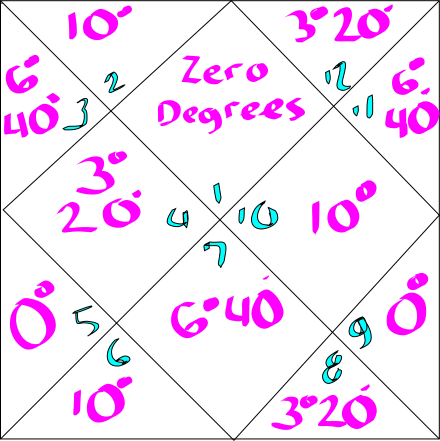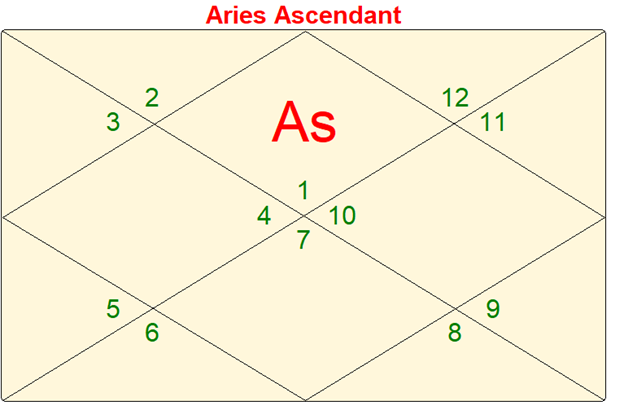|
The following is from a presentation I gave to the Colorado Ayurvedic Medical Association a couple of years ago. Download it at the link immediately below or see the Scribd file that follows.
0 Comments
Perhaps you find yourself self-pressured to know the particular nakshatra of a planetary placement, given only the degree and sign. I know I do.
Here is an easy way to remember the changes. It all has to do with the inherent trinal nature of the four elements in the chart. Since nakshatra lords also have a trinal quality, we can borrow the structure of the elements in signs to extrapolate to nakshatras. Fire signs (Aries, Leo, Sagittarius) start off the zodiac and represent a complete set of nine nakshatras, one for each of the nine graha. As they are the start, the degree at which the nakshatra sequence begins is zero. Earth signs (Taurus, Virgo, Capricorn) come next and you just have to memorize that their starting point is at 10 degrees. Air (Gemini, Libra, and Aquarius) come next and represent a step down by one pada (a quarter of a nakshatra) to 6 degrees and 40 minutes. Water (Cancer, Scorpio, and Pisces) come next and represent one pada down, so 3 degrees and 20 minutes. If you want to consider it again, water to fire represents one pada down, and so we are back at the start of the cycle, to zero degrees. You can even extend the theory one more back to the earth element as being -3 degrees and 20 minutes which is another way of remembering it is equivalent to 10 degrees (since each nakshatra is 13 degrees and 20 minutes). It is important to note that each element has a different degree at which a new nakshatra starts, that this is repeated 3 times, and that they step down by 3 degrees and 20 minutes with each one. Ultimately this mnemonic references the repetition of 27 as the number of nakshatras and 108 as representing this magic number of nakshatras happening four times. The four elements represent this repetition of four. As a further help, each pada of a nakshatra also maps onto a whole sign in the navamsha. Thus the nakshatra cycle of 27, each of which has 4 padas, walks us through the navamsha 9 times. Surely, this has meta-meaning given the beautiful quality and unique mathematics of 3 (the number of Jupiter) repeated in 9, 12, 27, and 108. Feel free to ask any clarifying questions. Abstract
Contemporary astrologers are challenged like never before to make their work scientific. This is especially true for astrology researchers who are stewards of the keystone for legitimacy in astrology. Fortunately, current strides in artificial intelligence allow new avenues to data cultivation for the public and private astrology researcher. The author presents her freely available solution to the challenge, using in her explanation basic, intermediate, and advanced concepts. The Challenge Astrologers the world over from all times, whether Eastern, Western, Persian, Chinese, or Tibetan, face the same challenge. Event data of time, place, and date, including that of births, are mandatory for us to do our work. Acquiring that data is more difficult than at first blush it may appear. For example, if one is interested in sports astrology and one wants to know the start of a basketball or cricket match from five years ago, how does one actually find that? Perhaps there is an online news article from that time, but there are likely to be hidden problems. What I have found is that there is a wide variety among news publications as to how they treat such events. For example, BBC will include the time of the match in subsequent or preceding write-ups, while The New York Times will not. Another part of the challenge is the language used in an article. For example, the article may say something like “the match happened last Sunday”. The New York Times often uses such an approach, begging the questions of which Sunday is that and what is its date. It may be obvious to the contemporaneous online reader but not to one years thereafter. Then, there is a question of whether those articles are even archived and hence publicly accessible for some time later. Often, only the articles subsequent to an event are kept posted online and then only for a few years. Finally, there is the strong possibility of an astrologer not knowing that the event exists in the first place. For example, let’s switch our focus to cyclone event data. There was a cyclone in the Spring of 2019 named Cyclone Ida. There are hundreds of cyclones per year. (National Hurricane Center, 2019) Twenty years from now, will an astrologer who is interested in cyclones know to do an online search of contemporaneous literature for that particular cyclone? Will there still be material online for that cyclone? Doing astrological research is difficult. For the cyclone researcher, he or she may need to pore over tens of thousands of webpages just to get that kernel of truth of when, where, and what time a batch of cyclone events occurred. Reading that many documents takes time. Even if a list of ten thousand website URLs were presented instantly to the researcher, spending three minutes to scan each article would necessitate a solid 21 hours straight of such focused activity. That is not counting the search itself for the URLs or the recording of the results. Given these daunting facts, there is no wonder as to why astrological research is relatively rare and often scanty or incompletely done. Science, by contrast, demands first and foremost the relative accuracy and completeness of data. This core difference between astrological research and conventional science represents the deepest chasm between the two world perspectives. Bridging this chasm of data completeness would do the most to unify the work of all astrologers everywhere within the paradigm of science that could be said to define our current societies. The Solution A data challenge needs a data solution. The Information Age in which we live deluges us with data. Fortunately, in these times, we are being presented with newly hatched tools to automate the search for and the processing and retaining of data in bulk. The newest and best methods use artificial intelligence (AI). At this time, these AI tools are being used throughout every industry except astrology. These tools presently are also not for the mathematically faint of heart, so there is still a pretty steep learning curve for implementing them. Commercial industries find that the effort directed to the computational and mathematical gymnastics is more than worth it. The results are phenomenal, world-changing, and transforming to the industries even as the computer science in use is still relatively in its infancy. What is needed is a means of using these tools to help the future astrology researcher who is within that exponentiating global data deluge to find and record the relevant data that was previously preserved as it happened. Just as astrologers use books for transmission of knowledge, email for communicating with clients and each other, and software for chart generation, it is time for astrology to join the rest of professional society by investigating and employing the latest machine learning methods to generate artificial intelligence within astrology. Event data generation is the first order of business for the personal or public research astrologer. Using artificial intelligence on global public information to cultivate event data should be the first order of business for a current computer scientist who wishes to help astrology. Basic Ideas There are a few steps to a computer-automated processing of current event data to help a future astrologer. A computer program would be needed to 1. monitor daily current events as they are published in online articles. The computer program would then need to 2. linguistically digest the complex language of online news to find A. the nature of the event (for example, a new cyclone) and B. the date, time, and place of the event. After digestion, the computer program, at a minimum, would need to 3. preserve A. and B. for future use. The basic triplicate of requirements of monitoring, digestion, and preservation of astrologically relevant data in a timely manner is in truth a cascade of separate algorithms, or sub-programs, each of which has only been developed recently, sometimes as recently as just a few months ago. Monitoring can be done through a process called web scraping, wherein the texts of new articles are programmatically gleaned. However, of the millions of new articles that get published per day, which have data relevant to events of interest to the future astrologer? There is a computational cost to aggregating such monitored data. Even if the program takes but one second per article to seek out, acquire, and analyze for relevancy the text of the article, only 86400 such articles could be processed per day for this step alone. Thus, for current network, hardware, and software constraints, a necessary restriction in the numbers of internet sources and research topics is required. Digestion is the most technically challenging part of the three-step process. The computer program would need to do nothing less than understand language itself. Take this sentence as an example: “Last Sunday night, three hours after kickoff, the Chicago Bears won the Super Bowl championship against the Denver Broncos.” The program would need to know that A. the article is about a match in American football and B. what was last Sunday’s date. The location and time of kickoff would, one hopes, similarly be determinable through other sentences of the article. Digestion makes heavy use of something called natural language processing, a field of artificial intelligence that is still rapidly improving. The following two sections explore this step in some detail. Finally, preservation of the data in a central, publicly accessible repository is the last, necessary step to the program. This is the easiest step of the three and typically just requires publishing the data file online. Intermediate Ideas Natural language processing (NLP) across different languages and across different subjects is a wide computer science field with many compartments. The main ones of relevance here are automatic summarization, natural language understanding, and question answering. Automatic summarization is needed to determine whether an astrology research topic is indeed the topic of the article. Typically, this is done by condensing the article into a small summary and seeing if the topic is present therein. How does one determine the summary of an article? The non-trivial prospect of text extraction and synthesis based on statistical significance metrics and pattern-matching is a relatively straightforward type of summarization. These days, abstraction of language content is also often required as well. Machine learning based on linguistic feature extraction is at the core of this memory- and computation-heavy abstraction process. As a sub-field of NLP, automatic summarization benefits as being one of the longest studied topics of it. (Hahn & Mani, 2000) Natural language understanding is the study of how to improve comprehension of text by a computer. It is a necessary middle step to answering questions from the text. The reader may be familiar with interfaces for language understanding from Siri, Bixby, or Alexa apps on their cell phones. Such commonness belies the extraordinary technical achievement that they represent. For example, one may say “The man started on a new novel,” and “The man started on a sandwich”. The formal structure is identical even though the meanings are wildly different. Finally, question answering is critical to the astrologer’s needs. Even with the well-understood text of an article whose topic was deemed relevant, asking questions of the article is also non-trivial. Fortunately for astrologers, there are only three main questions. On what day did the event occur? At what time of day did the event occur? In what town did the event occur? However, the news article may be ambiguous on these matters or it may not include these details at all. For example, for a cyclone, what counts as the birth event? The initial early formation far off at sea? Landfall? Landfall only reaching a major population center? Such delicate domain-specific answering to a question is only lately, in the past few years or so, reaching maturity. Advanced Ideas The implementations of automatic summarization, natural language understanding, and question answering that are useful to know about for my project involve neural nets. Neural nets, a.k.a. artificial neural networks (ANN), are a way for the computer to solve problems of NLP that is lightly based on how biological animal brains work. Their loose depiction is as follows. The seven chakras have an especially important role in yoga, Ayurveda, and Jyotish.
They are energy centers on which we can depend for the integration of the physical, psychical, and astral bodies. Here is a purported connection of the seven chakras to neve plexi In Vedic numerology what we are really talking about are the symbols of number with their equivalencies in graha (the Sun, Moon, nodes of the Moon, and planets) and symbols of space as relevant segments of the zodiacal belt. Just as there is a language to numbers, namely mathematics, there is a corresponding language of space-time through the moving graha, namely Jyotish. The Vedic assignations of number and graha are as follows: 1 is the Sun & the sign of Aries, 2 is the Moon & the sign of Taurus, 3 is Jupiter & the sign of Gemini, 4 is Rahu & the sign of Cancer, 5 is Mercury & the sign of Leo, 6 is Venus & the sign of Virgo, 7 is Ketu & the sign of Libra, 8 is Saturn & the sign of Scorpio, 9 is Mars & the sign of Sagittarius. The reasonings for the associations that I have come up with are below. 1 is the Sun & the sign of Aries This association is an easy at-bat. The Sun is exalted in Aries. This makes sense as the Sun is the king (among other significations, but this article will try to keep things simple), and Aries is the battlefield (same). The king’s highest moment is on the battlefield. Besides exaltation, it also makes sense to look at the lordship of the Sun. That is Leo, here in the fifth house.
For the Sun’s own sign to be in the fifth house is especially proper as that house indicates the beating heart, the liver, and other physical indications of the Sun. So, the nomenclature for this article is to name the exaltation house and lordship house(s) in the following way: E1:L5. The utility of this will hopefully be clearer as time goes on, and a summation will be in the final paragraph. 2 is the Moon & the sign of Taurus [This essay won the grand prize for our 2020 holiday essay contest.] I visited Renay last fall, while my husband was away working in a refugee camp in Kenya, and we were nearing a big transition. After several years of living in Boulder – a lovely bubble – filled with adventures, graduate degrees, stability, and friends, we both felt the urge to live abroad again, to be less comfortable, to make a big ripple and avoid getting complacent. When I met Renay, we were planning to leave the US in January of 2020. The idea was to spend most of our time in India, with no distinct plans for where exactly we would be, what we were going to do, or how long we would stay away. The questions I asked Renay during my Jyotish session were related to the broad arc of this lifetime: What is my role in all this? Being highly trained in both science and yoga, what is the proper balance? How can I be most helpful to the world?
In late January, we packed up, rented out our condo, drove from Colorado to North Carolina to leave a car at my parents’ house, and flew to Rishikesh. We arrived at a large ashram on the banks of the Ganges, a place we had visited four years earlier – a place where we could land and do helpful volunteer work for a while as sevaks. We ended up staying at the ashram for five months, three of those in tight lockdown, not allowed outside the gates to walk in the forest or even take the few steps to the river (except for a brief window in the early morning allowed for Ganga snaan – bathing at the ghat). It was a beautiful prison, with gardens full of hibiscus bushes, roses, and ancient bodhi trees. During this time of being locked in the ashram, I didn’t wear shoes for three full months – not even flip-flops. Over the course of my conversation with Renay, I learned that I had been under the “gaze of Saturn” for the past ~19 years, and that this cycle would lift around May 2020. Near the end of our discussion, I asked an aside question about how children may or may not fit into this lifetime (my husband and I had always been undecided about whether that was the right path or not, given the environmental, social, karmic, and other considerations involved in such a choice). After consulting the charts and noting some interesting related observations, Renay told me that if we decided to pursue that route, May 2020 would be a conducive time for conception. Otherwise, January 2021 would be the next optimal window, and then not for a few years. At some point this spring, as the COVID-19 pandemic spread and we were locked in the ashram in Rishikesh, it became clear that becoming a mother may indeed be the right path. After thinking about the logistics, consulting a doctor staying at the ashram, as well as one of the spiritual leaders, we decided to do an experiment – in May 2020. Perhaps unsurprisingly, it was successful, and I confirmed I was pregnant soon after we left the ashram in June to move to a village higher up in the Himalayas near Uttarkashi, along the main upper tributary of the Ganges river called Bhagirathi that tumbles down from Gangotri glacier. Fittingly, the name of the village was Matli – which means “nausea” in Hindi or Sanskrit (highly appropriate for early pregnancy). Of course, unbeknownst to us when we arrived, there happened to be a couple of American doctors (one a midwife) from Aspen, Colorado living in the village, and running a mission clinic and women’s health center. Things always seem to work out this way and fall into place. Were we out of our minds? Being pregnant, in a small Himalayan village, in the midst of a global pandemic, with no distinct plans for the future, could make it seem so from a certain perspective. But somehow it was perfect. After about three months in Matli, including more lockdowns, the Indian monsoon, a few highaltitude Himalayan treks, and many delightful motorbike rides through the terraced green idyllic surroundings crumbling with landslides, we descended from the mountains and made our way to Kenya at the end of September. We spent the following two months living at the edge of Lake Naivasha, a magical place with giraffes and zebras, and hippos who come out of the lake at night, and now in December we are back in the US, residing with my parents for a few weeks on the coast of North Carolina before driving out to Colorado around the end of this year. I started a new job as a postdoc at Dartmouth College this fall, working remotely for now as the pandemic rages, but we will move to New Hampshire in the summer. After several months of not being formally involved in science work, this feels like the right balance again. The baby is due in late February, and she is moving quite a lot these days in her personal womb universe of my body. She has already been immersed in some extraordinarily beautiful places, from being conceived in Rishikesh, to high Himalayan glaciers, to the Maasai Mara in Kenya. After learning I was pregnant, a friend asked out of curiosity if we had been trying for a while. I told her it happened immediately in the first month of the experiment – but to be fair, that we had the advantage of a Jyotish astrologer advising me that May could be a good time. I say it laughingly to friends, but it obviously was accurate. Of course, I ask myself the questions: What would have happened if we had waited? And perhaps more importantly, how would this have played out if I hadn’t met with Renay at all? The net is beautifully complex and full of wonder. This year, 2020, has been interesting and challenging in different ways for everyone, everywhere around the planet. It seems fitting that Jupiter and Saturn are the closest together in our sky that they have been for the past 400 years (since Galileo’s time). After recently emerging from my time with Saturn, I suppose I feel a special friendliness toward what that planet represents, almost as if being in on some sort of cosmic joke. Onward we go, with curiosity, steadiness, and a smile, as we tumble along the arrow of time as we perceive it. We’ll see how this goes, spinning threads and tracing arcs. [This essay won the first place prize for our 2020 holiday essay contest.] My study of Jyotisha was my anchor this past year helping me weather the crazy climate surrounding us all. I discovered this science while exploring Ayurvedic practices. I had a marma massage with an ayurvedic practitioner and as a part of her protocol she explained other ayurvedic offerings. She explained their purpose, how they worked and the advantages to overall health. Those few moments of personalized care were the foundation of a new interest. At the time I was studying herbal medicine and much of what she shared was reflected in what I was learning about herbs. She detailed the dosha Ayurvedic theory and encouraged me to research their properties on my own. That exploration led to more questions and, eventually to a vedic consultation with Renay.
That first teleconference with Renay was surreal, in an enlightening way. She read my chart as if she had known me a lifetime. Listening to her, I felt as though she knew me better than I knew myself. I was intrigued and deeply curious. I have spent a great deal of my life not fully understanding my purpose and have questioned how and why I choose to live as I do. I often wondered why I wasn’t like my siblings and my personality was so different from those closest to me. Renay touched on just a few of these things and I felt a stirring. I sensed she had answers and I wanted more. I knew I had stumbled upon something important for me. I jumped at the chance to continue the discussion and asked for guidance. Renay provided information on how to get started. When I begin to read Light on Life by Hart de Fouw and Robert Svoboda, I felt as though I wandered into a secret world. The words I was reading felt like they were written for me. The information in the chapters made sense and suddenly I was looking at my world with a new sense of wonder. The planets became real to me. I befriended them. It felt a little crazy when I began conversing with the universe. Maybe a bit awkward, but not uncomfortable. This reaction was similar to the experience I had when I began the study of herbalism. As I learned about new herbs, and their properties, I sought out places that they grew. It became a part of my daily routine and it continues today. Once discovered, I would sit with the plants, observe them and, yes, the conversations started. Now I had the planets to befriend as well. The pattern of my day was altered. Life became much quieter for me as I relished time spent just listening to my surroundings. The plants, and the planets, both became an important priority. Although I enjoy being social, this study of Jyotish also spoke to another side of my personality. I have always needed quiet time. I think coming from a large family, with very few boundaries, I seek solitude. It was hard to carve out time just for me. This science spoke to that need in me and I began to crave the peaceful feeling I felt while reading and absorbing new ideas. I was thankful that I discovered this study of all things Jyotish when the pandemic hit. With some experience under my belt, the time was right to fully embrace the subject matter. It was balancing as crazy activities swirled throughout the world. Each day brought clouds of confusion and conflict. It was hard to listen to any media and discussions of appropriate behavior and basic human rights became a daily challenge in conversation. The Jyothisha study of remedies was one of the first practices that came easily to me and I depended on many remedies in the past year. The book, Yoga of the Planets by Andrew Foss, PhD sits at my bedside. Meditation had been a part of my routine for some time and I looked forward to more time on the cushion in the past year. That practice, along with mantra, kept my life flowing peacefully. I was raised a Catholic but have not been a practicing Catholic for a long time. I missed the ritual, the ceremony and the mystery that unfolds in religious practice. Jyotisha fills that space for me and offers an opportunity for my spiritualism to once again grow. Moments of being still, embracing silence, and studying seemed to provide the avenue I needed to keep my mind in a sense of harmony. It struck me that I had been missing that spiritual connection, that daily practice. Jyotisha has taught me that each day of the week is a gift and each day carries with it very significant feelings. The days are even color coded providing yet another dimension to their significance. I worked at greeting each morning with enthusiasm and energy and hoped it would carry me through the day. As the days passed, that simple practice often washed away the dreariness of being locked down. I cannot believe how I had taken something like the days of the week so for granted. I had never considered honoring them. It was a delight to feel in sync with their energies. It has become almost second nature now. Developing a relationship with Saturn was a priority as I am in my Saturn dasha. It took some time, but I now feel very comfortable with his presence in my life. Considered a fearful planet, I learned to embrace his helpful qualities. I never leave dishes in the sink because of him! Rahu and Ketu are another fascination and I have yet to fully understand their abilities and their energies. When turmoil snaked through my daily activities, giving me pause, I wondered if they were at play. Despite the upheaval swirling about, I knew I was one of the lucky ones. My home sits on 40 acres and is in a remote area. My grown children are watching over my grandkids. Just into retirement, I am thriving. This pandemic allowed me even more time to indulge my interests. Of greater consequence was my anger toward politics, and our political leaders. I used Jyothisha to soothe my psyche and settle my heart. Political antics, as played out in the media, rattled me to my core. Was this Mars at work? Ever searching, my astrology app is consulted early in my day. I look with anticipation of planetary movement. I watched for signs, often not really knowing what I was looking for but hopeful for some insight. Was all this chaos predestined? The teachings of Jyotisha seemed to indicate that but I was not totally convinced. Believing everything happens as it should, I still have questions. I read Vedas. Of the science I was able to understand, it seemed definite. My part in all of this was to embrace the not knowing and allow the answers to reveal themselves. With hard work, it is just a matter of time. Afterall, I have a strong Jupiter in my first house. Somedays I am totally confident and feel like I truly understand what is happening in the skies and how planetary activity is affecting me. But other days, I am as confused as I was during my first consult with Renay. As they say, the more you learn, the less you know. I question my abilities to really grasp this complicated subject, but my intention is genuine, and I carry on. Frankly, I doubt I will ever be able to offer anyone else a reading. This study for me is very personal. So much of what I have learned really speaks to me, who I am and what my purpose is. I am planning on a lifelong study with no final exam. It was that very thought that was running through my mind when I was considering not finishing this essay. As I wondered about the house, distracted and unsure of what I had been writing, I noticed my dining room table, and the blanket of quilt fabrics covering its surface. My sewing machine sits knowing that at any moment I may plop down and put together a quilt square. It has been many months since the top of this beautiful dining room table has seen the light of day. Instead, I leave all my sewing tools visible in case the mood strikes me to quilt. My husband is quite agreeable to this strange process, noting it fits my needs and seems to make me happy. Often, I work for only a few minutes and move onto other projects. And then some days I can spend hours sewing and piecing fabric. In this passing moment I was struck that I was just afforded another lesson. I just had to be still to see it unfold. A quilt starts with just one piece of thread, just as we are born in one single moment. And we grow from there. Life takes flight. Each of us, individually created, come in diverse colors and patterns just as each of us are born under different planets. Piece by piece, the pattern is revealed. Understanding how you fit can take a lifetime or it may come together without much effort. Alterations and remedies are available. My goal in quilting is to stay mindful of the process and enjoy each piece I work with. The more patient I am, the better the project comes together. The result is only a small part of the process. The journey to that place is what really matters. Allowing your senses to enjoy the activity, to embrace the creativity is really the best part. For me this is what this past year has been about. Just like an heirloom quilt, Jyotish was draped across my lap, comforting me, warming my heart and making me feel a bit more secure. Because of this study, I now strive to allow each day to unfold as it will, knowing that there is plan. Moment to moment life changes, as do the skies. Jyotish has taught me to stay mindful, be aware and open to what is happening. I do not have to understand every detail. If I stand as a witness and remain open to the experience all will be as it is supposed to be. This belief has strengthened my health, my heart and my mind. I have stopped worrying about what if’s and why’s. I hold today with respect, honor the past and prepare to the best of my ability, for the future. [This essay won the first place prize for our 2020 holiday essay contest.] “What even is time?” a friend asks me over the phone. This question has
become like a catch phrase for us. At the end of 2020, a year unlike any we’ve experienced before, we barely know what day it is from one moment to the next. While we’ve seen many structures we may have taken for granted—our hospital systems, public trust in science, leadership, the economy, the postal service, social safety nets, physical and mental health, basic collective agreements about reality-- buckling under the stress test of this year, there have been some “givens” breaking down that reveal treasures in the rubble. Perhaps our relationships to time are in this latter category. 2020 has only deepened my questions about time and how it works in and through my life, and in this way it has deepened my relationship with Jyotisha. In a year that both heightened the pitch of change and uncertainty in the world while also introducing new levels of monotony to my days, I’ve leaned on the intricate assurances of this field of knowledge. The practice of Jyotisha not only prepared me for this strange season, but it has also helped me cope and make sense of it from within. It’s been many years since my life had any illusion of “stability.” By the time I reached my mid twenties, I’d watched in horror as my major plans crumbled around me...several times. I looked back and realized I had seen every demise coming but had thought I could fight it. In a wicked quarter life crisis, exhausted and bereft of dreams, I wondered if I had been weak or just stupid. I had the distinct sense that some larger force was moving me around with all the other little pieces, and I became obsessed with trying to understand the mechanics of fate. With no grounding or support in this endeavor, though, I felt like someone flailing about in unknown waters. I followed a nudge into a yoga teacher training and attempted to chart an extra curricular course of study for myself that might reconnect me to a sense of trust and intuition. Deep down, though, I just wanted someone or something to tell me what I was supposed to do with my life. I kept trying to put myself in places where I thought a bolt of “aha!” lightning might strike me with the epiphany of my true purpose and authentic self. Then I could be an adult. Then I would know what to do next. One day, a woman in my yoga teacher training announced she was pregnant. This was a surprise to her, but, she said, it shouldn’t have been; her Vedic astrologer had told her a year ago it would happen when it did. Other classmates reported similar revelations from their consultations, and I wondered if Jyotisha might be my “aha!” lightning rod. It was, but of course not in the way I expected. As I entered the dance with this ancient way of knowing, my understanding of time, rhythm, and movement would slowly stretch in all directions. The “aha!” I previously looked for as a sudden exclamation would turn out to be a longer, sustained song—a note sighed from a full breath, spiraling around to overlap and harmonize with itself, then breathing in and out again for more. Five years later, I still refer back to that first astrology consultation and find support in the framework it offered me. The laws of cause and effect are vast—some too large or too small to be noticed by the naked eye of the moment—but here I was offered a musical score of how those energies had been set into motion around my individual experience. With this notation (and a skilled interpreter), I could learn to dance with the music of my life instead of against it. And as this helped me to relax my anxious planning mind, I could also learn to better listen to the symphony of the present. These calculations brought the subtle poetry of my life into relief so that it could be read, uttered, and understood—whether it is deeply felt inner friction from childhood, twinges of sadness in the themes of my art, or rumbling premonitions of what would come. While sometimes surprising, more often than not, my yearly astrology readings would validate my own intuition about what was ahead (or behind), helping me to develop my own knowing. I began to incorporate this wisdom into everyday life; especially as a way to remember that just because I’m experiencing something now doesn’t mean it will always be this way. In the meantime, I can weave these personal timelines together with complementary practices of asana, mantra, and Ayurvedic diet. At first I thought I would be engaging in all this alone. I made that first phone call in secret because I didn’t think I wanted my friends or partner to know I was investing in something so many people underestimate and dismiss. The revelations of Jyotisha were too profound to keep to myself, though. My partner was open minded, but he was truly converted when, after a rocky year and a half of jokingly hoping the astrology was right in predicting our luck would change on a certain date, it did. Dramatically. He now gets regular readings as well, as do many of my friends. I often give them as gifts so we can remind each other and reflect back what may be happening as time unfurls around us. So my best friend could help me recognize when the “fruits” of my labor “didn’t taste good” at the job I needed to leave at the end of 2019. So my husband could remind me that even when all my work got cancelled in March of 2020, I was slated to have good professional work again in a few months. I couldn’t see how, but engaging with Jyotisha has taught me that I’m not responsible for making everything happen. I turned my worries over to the Divine in meditation one day, and the next day I received an email with news of a huge contract—right on time. In similar fashion, we were able to feel prepared for the pandemic to last as long as it has; we knew we were in for election confusion in November; and we had a sense of how we needed to manage our resources—energetic and material—through it all. Meanwhile, we’ve used the increasing dreamlike quality of the days and nights to explore the archetypes available to us as mentioned in our readings. What career lies in the “basement of the castle” that my husband may have metaphorically visited when he was 24? What mountaintop is mine to stand on, and what of the stars seen there can I bring back to share with others? And, more domestically, but no less importantly, can I feel and soothe my inner samurai when my husband is feeling blue and I want so badly to swoop in and fix it? My modest foundation in Jyotisha has helped me understand more about the learning process of this life, which helps me make sense of upheavals like the ones we’ve experienced in this challenging year. Whatever this is, it will pass, so I’d better relax into it and attend to the lessons alive in the now. Time is a magnificent teacher—too complex and colorful for the linear rows of tick-marked boxes our society tries to squeeze it into. It runs deeper than our attempts at control. Our lives might be enriched by allowing those boxes to get broken down—to let the long, slow “aha!” seep through the moments elegantly strung together for us to experience in our souls’ becoming. [This essay won the second place prize for our 2020 holiday essay contest.] Ebb and flow, push and pull, the nature of tides, oceans of water, a ocean of light.
Yes I see the ocean of light- the undeniable tapestry in the sky. Each one of us reflects our own image back to the cosmos, back to source. So here I am- Here we are- experiencing this year in all of its intensity, Over there look, so many people and they are in trouble. Famine; Dis-ease; Standing … Fighting … Falling Then I hear the echo- a ripple from a 100 years before. How many others can now wonder how it was for the beings back then? Ebbing and flowing in 1920, oceans of water, ocean of light. Visions of the past bring me to the present. Each country in its own despair. Does anyone know what's really going on? Alas, there is hope. See it through different eyes. I take a slow deep Inhale Letting the breath out Letting the air expand in and out of my body United I become- In breath and body Moon is the masses. Mercury is the media. I begin to release my tension Now- look at this: Now … The Now. All the players in this Leela. The play of life There they are - the “celestial bodies”, “grahas they are the seizers” Everything is visible, Some of us are doing the seizing and some are being seized. I am reminded creator- preserver- destroyer; vata-pitta-kapha; sattva-rajas-tamas. Beneath the layers, those grahas, those “seizers” its all there. One with everything, I immerse myself Washing away the illusion, the Maya. There there it is - See those combinations? Yes I see their energy! Oh wow! Ok I see the correlation! And this too shall pass … The tapestry doesn’t lie Humbling me with its magnificence Every who- what- why can be solved. Gno-ing this … I Bow. Searching for truth and being able to find it, How amazing is that? Unwavering in my resolve to go deeper, the practice embracing me- as I embrace it. Prakruti, Vikruti … Vaastu- Jyotish directs me towards its sisters. Remembering Nikola Tesla’s words on learning the “secrets of the universe” … “Energy Frequencies Vibrations.” Making the cosmic connections in the Calamity that has been this year Energy- Frequencies- Vibrations- Energy- Frequencies- Vibrations Conjuctions, transists, dashas Only to realize how fortunate I am, (we are), to be part of it. No need to be in the dark Source energy, celestial happenings Chill out and breathe, I remind myself - it can all be explained I saw the fear at one point immobilizing me- immobilizing everyone. Only in the truth did I find comfort and peace Uncovering the mysteries of our lives with this Divine science. So much conflict on the planet, so I push on- digging deeper No need to spiral down, this is a lifeline. Everything will work itself out. Sun, Venus, Mercury, Moon … Rahu, Ketu … Saturn, Jupiter, Mars Seeing them- seeing me- seeing all of us Only with a Ganesh quality, a child like-ness full of wonder can I approach My house of mirrors and all nonsense then vanishes into the ether. The past, the present and the future All we need to learn from the tapestry This extraordinary gift of Jyotish the way to listen to their messages. Seeing the people, seeing the sky As above, so below The vast ocean of light reveals truth and I softly surrender to the ebb and flow. [This essay won the second place prize for our 2020 holiday essay contest.] I am breathing in and I am breathing out. As sure as the sun does rise, I am as sure that the sun sets. I am breathing out. I am breathing in. The moon also rises, and just as it does, the moon also sets. I am breathing. I am still breathing, and all the bodies that rise with life, they will all also set in their time and find death.
Oh twenty-twenty, what can be said? How did I see you? Was it as perfectly as vision can be given? From the isolation of doors shut, families and loved ones separated, with gloves and masks on, I saw the political colors blazing as gateways to change flew open. I found comfort in meditation and mind dazing stares at a candle. It was like the light, which makes darkness known, would give me the reasons why the cosmos manifests in all the ways that have been shown. Twenty-twenty, it gave me online global communities that raised me and grew me in new ways. Sparks of learning, very deep learning came to illuminate me. The light in the darkness of watching the stars, reading ancient observations, practices, and philosophies, they created in me a feeling of connections that were greater from a far. I saw so many yogas leading to strong times and weak times. Saturn and Jupiter, Mars, Mercury and Venus going through elaborate and difficult direction switches. So many traveling bodies through the knots, playing in the binds, bodies close together but not like bodies that are close together in loves kisses. How my lips miss kisses and my arms miss holding. So I explored, I am not my body, I am not my molding, but who am I? Watching, I kept the pieces moving on a board, some quickly passing where they had been when I was born. In some places I saw pieces amassed and like bodies attract and repel, my relationships in this world also rose and fell. Sometimes we are moving forwards, sometimes almost standing still, progression and regression and even moments of peacefulness did fill me. Moments, brief moments, showing me the abstract and non-linear motions of time. In a blink of an eye I could have actually missed it. And like our father, whose will be done on earth as it is in heaven, the motion of great bodies follow his laws. Even the dark and bodies without body did change at his command, and with it mood without form transferred darkness to different parts of the land. I did not anticipate all the collisions in the visions of the future and the past, but I did and will continue to watch them. Weaving stories and meanings from threads that may be but illusions, not real until I can see them, not known until their stories told. I am not my body. I am not even my mind. I do however want to know so I will continue breathing. Breathing in and breathing out, I will be. |
ARTICLESAuthorRenay Oshop - teacher, searcher, researcher, immerser, rejoicer, enjoying the interstices between Twitter, Facebook, and journals. Categories
All
Archives
September 2023
|
||||||
© 2008–2024 Renay Oshop AyurAstro®









 RSS Feed
RSS Feed